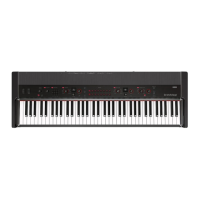15
Reverb/delay settings
These are the settings for the reverb and delay effects.
Four types of reverbs and four types of delays can be set as
effects.
Type Details
HALL This is a hall-type reverb that simulates the
reverberations of a large concert hall or
ensemble hall.
STAGE This reverb simulates a stage with less
reverberations that that of the hall type.
ROOM
This reverb simulates the reverberations of a
small room. The reverb includes multiple initial
reections of the sound from the walls and ceiling.
SPRING This reverb simulates the spring reverb sound
used in some guitar amps and organs.
DELAY This is a simple stereo delay.
CROSS This is a stereo delay that bounces back and
forth from left to right.
TAPE This eect models the analog tape echo found
on popular devices. The eect recreates the
changes in tone from sound distortion and
vibration produced by the rotation of magnetic
tape and the motor. This oers a warm echo
sound.
MOD DLY This eect adds a pitch shift-type eect similar
to a chorus eect to a delay, creating a swelling,
wobbly delay sound.
1. Press the REVERB/DELAY button.
The LEDs of the button and the selection knob will light,
and the effect will be applied.
2. Use the selection knob to select the eect.
3. Adjust the amount of the eect to apply with the
DEPTH knob.
The value will be shown on the LEDs around the knob.
Reverb type is used to control the reverb level, and delay
type is used to control the delay level and feedback level at
the same time.
4. The delay and reverb times can be adjusted to
match the intervals at which you press the TIME-
TAP button.
The button will blink at the interval that is currently set.
Note:
The reverb time will be set to the interval between
taps, when you tap the button four times.
When using layered or split sound, the effect volume balance can
be adjusted with the “Reverb Send” effect edit parameter in the
KEYBOARDS and ENSEMBLE programs.
The settings in this section can be saved as a favorite.
Reverb Send
KEYBOARDS
program
Reverb Send
ENSEMBLE
program
The sound can be played right after changing the reverb or delay
effect settings, but the settings will return to their previous saved
state if you select a different favorite or turn off the power. To
save your settings, be sure to write the favorite to memory. (Refer
to “Saving a favorite that has been changed” on page 13.)
System settings
Types of system settings
The settings that can be made here include overall settings for the
Grandstage including master tune, MIDI, controller functions and
so on.
•
Master tune
•
MIDI channel settings
•
MIDI channel mode settings
•
Lower part MIDI channel settings
•
Local control settings
•
Velocity curve settings
•
Convert position
•
Auto power-off settings
•
Adjustments made to display brightness
•
KORG logo backlight (on/off)
•
KORG logo backlight color
•
Foot pedal functions
•
Foot switch functions
•
Pedal calibration
•
Restoring the Grandstage to factory-set default settings
•
Saving/loading favorite settings
Any changes made to these settings will be automatically
written to memory within several seconds, and will be saved
even after the power is turned off.
Steps for making system settings
The steps for making system settings basically involve the
following operations. Separate steps will be provided for steps
that differ from what is written below.
1. Press the SYSTEM button to turn it on (the button
blinks).
The word “SYSTEM” will display on the top line of the
KEYBOARDS section display.
2. Select a parameter using the VARIATION knob of
the KEYBOARDS section.
Each parameter is shown on the second line of the display.
SYSTEM
Master Tune
0 (440.00 Hz)
SYSTEM
MIDI Channel
1
SYSTEM
Save .FAV File
[Press EDIT]
SYSTEM
Load .FAV File
[Press EDIT]
3. Set the values using the LEVEL knob in the
KEYBOARDS section.
The values and setting details are shown on the third line of
the display.
Changing these values will immediately apply them as
system settings and save them to memory, even after the
power is turned off.
4. After you are nished with the settings, press the
SYSTEM button or the EXIT button.
The SYSTEM button will go dark.
System setting parameters
Master Tune
Sets the tuning for the entire keyboard.
Tuning can be set in cents (1 semitone=100 cents), within a range
of ±50 cents (427.47... 440...452.89Hz). The default setting is
“+0”, or 440Hz (the frequency for A4).
MIDI Channel
Species the MIDI channels on which the Grandstage will
transmit and receive (from 1–16).

